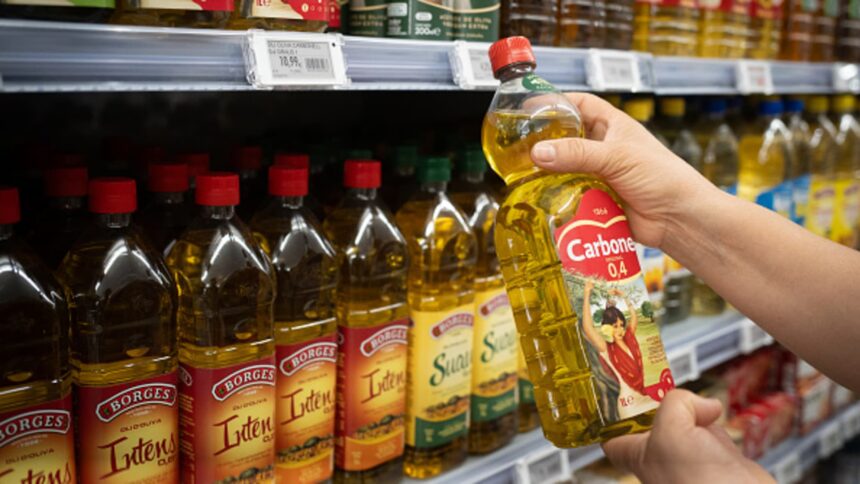Jure Susac, a Bosnian olive farmer from the town of Ljubuski in western Herzegovina, delivers his harvest to an oil factory in Capljina, during the harvest season, on October 29, 2022.
Elvis Barukcic Afp | Getty Images
Deoleo Spain, the largest producer of olive oil in the world, said one of the most challenging periods in the history of the industry appears to close, with “liquid gold” prices expected to almost half of the all-time high over the coming months.
Periods of extreme weather and climate-induced drought in southern Europe have hit the olive harvest in recent years, culminating in a price hike that has alarmed industry veterans and consumers alike.
Shortages of olive oil, the superfood staple of the Mediterranean diet, are pushing the industry into crisis mode, fueling food insecurity and even fueling a spike in crime in Spanish supermarkets.
However, prices are starting to cool down, as industry forecasts show a better harvest in the 2024-2025 season, especially in major producing countries such as Spain, Greece and Tunisia.
“Although there have been steps towards improvement, it would not be accurate to say that the crisis is over,” Miguel Ángel Guzmán, head of sales at Deoleo, told CNBC via email.
“We are still experiencing a phase of tension in olive oil prices, especially in higher quality oils, such as Extra Virgin,” said Guzmán, noting that there is still some market uncertainty ahead of the olive harvest for the 2024-2025 season. .
“However, the outlook is positive for the coming months, as the market is expected to stabilize and normality is expected to be restored as the new harvest progresses and supplies increase,” Guzmán said.
‘Gradual normalization’
Deoleo, the producer of household olive oil brands such as Bertolli and Carbonell, described the perfect storm of challenges as “one of the most difficult times in the history of the sector” over the summer and called for a “profound transformation” in the industry. .
The price of extra virgin olive oil in Spain’s Andalucia was around 6 euros ($6.33) per kilogram as of Nov. 6, according to Expana, an agricultural and food market intelligence company. That’s down about 19% month-on-month and almost 35% from the record high of 9.2 euros in January.
Spain accounts for more than 40% of the world’s olive oil production, making it a global reference for prices.
A man holds a bottle of olive oil on June 21, 2024, in Barcelona, Catalonia, Spain.
Europa Press News | Europa Press Getty Images
“The relaxation of prices in origin will begin between November, December and January, if the weather and harvest conditions remain stable in the coming weeks,” said Guzmán.
“The sign is that if everything develops normally, especially if the rains continue to benefit production, we can see a downward trend in prices during 2025,” he said.
Deoleo said the price of olive oil should drop to around 5 euros per litre, down significantly from the 9 to 10 euros, which has been the norm in Spanish supermarkets this year.
“This price will be reasonable in the context of increased production, which will reduce market tension and facilitate the gradual normalization of prices after a period marked by volatility,” Guzmán said.
‘Existential threat to industry’
Kyle Holland, senior market reporter for oilseeds and oil at Expana, said most industry players were “very, very bearish” about the price outlook.
“The production numbers are key. For Spain, we could see 1.3 million metric tons, compared to last season’s 670,000 to 680,000 metric tons, depending on who you talk to, so it’s not far from double.
In addition to Spain, Expana’s Holland said bumper olive harvests are expected in Greece, Tunisia and Turkey, noting that olive quality is also “very good”.
“Most people are very, very bearish. They don’t see how prices can go up with the amount of supply we have,” he added.
An aerial view of farm workers washing grapes, with a mixture of water, olive oil and potassium carbonate called “posata” to make them look brighter and protect them from the scorching sun in Menemen Plain of Izmir, Turkiye on August 27. , 2024.
Anatolia Anatolia Getty Images
Deoleo’s Guzmán said the two consecutive years of drought have raised concerns in the industry, “which must adapt to an uncertain future due to climate change.”
In response to this challenge, Guzmán said that the olive oil sector is undergoing significant investment in new agricultural technologies and developing more resilient olive varieties.
“This is very important, because climate change has been identified as an existential threat to the industry,” he said.




